Scam Artist
Is crypto a scam? Is art a scam? Steve Pikelny’s winking answer to both questions is yes, and his work explores what happens when the art and the crypto are one and the same.
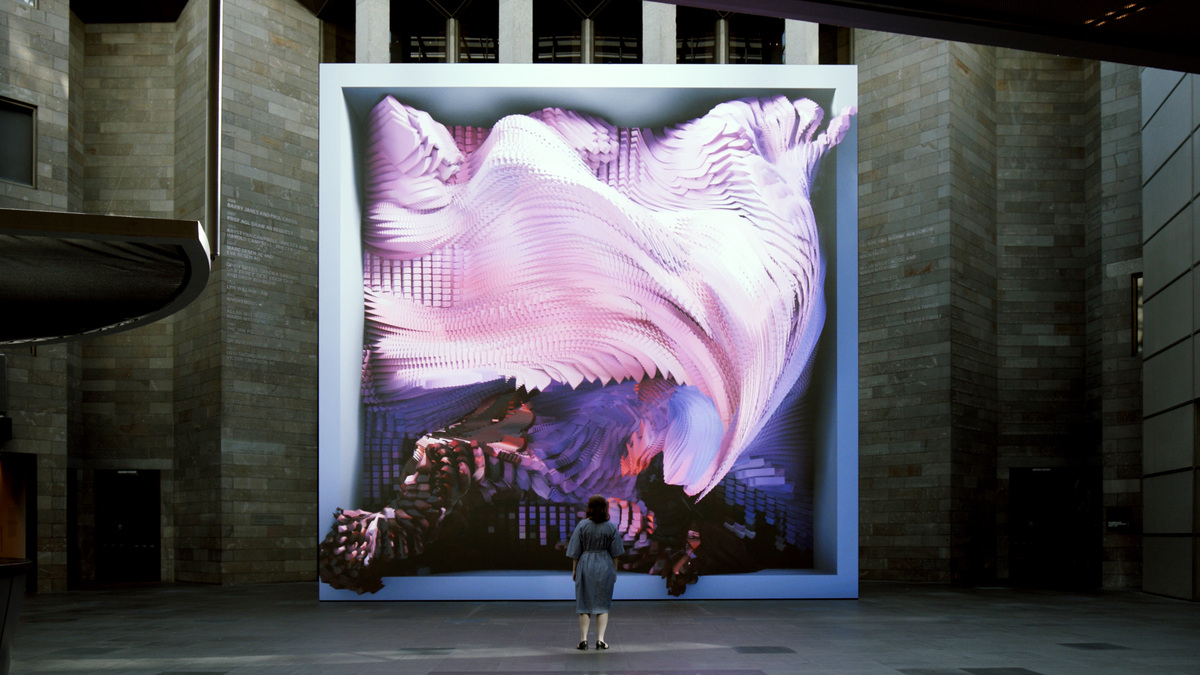
On the screen in front of me, a yellow puddle floats weirdly above a mostly barren landscape, casting a shadow on the beige ground. To judge by the size of the humanoid figures scurrying around it, the puddle has the dimensions of a smallish backyard swimming pool. But then again, I can’t really be sure if the creatures are comparable to average human adults; beyond their general form and bipedal gait, they don’t resemble any humans I know. With somewhat enlarged heads and animalistic faces, they tend to flock close to one another. Some of them run excitedly toward some activity off to the side of the visible space. Others just stand in place for a while. Occasionally, a group will kneel around an object, as if worshipfully. It’s hard to understand what they are doing or why.
AI art needs to be regarded in terms of its materiality, its temporality, and its relation to embodied, tactile existence.
The difficulties I have in parsing the action in Ian Cheng’s digital artwork Emissary Sunsets the Self (2017) are not incidental; they stem from the mismatch between my perceptual abilities and the invisible algorithms, known colloquially as “artificial intelligence,” that drive the scene. Though often judged by its spectacular images, AI art needs also to be regarded in terms of its materiality, its temporality, and its relation to embodied, tactile existence. The human body plays a central role in processing contemporary artworks that use machine learning algorithms to generate their images, serving as a kind of presubjective filter through which the generated stimuli—often too many in number, their motion and calculation too fast or too minute for conscious perception—are strained. It is through this filter that the artworks’ extraperceptual dimensions are first felt, however indistinctly, before they are reduced or rendered into an image-object. Through a phenomenological analysis of three (otherwise very different) AI artworks, we can understand more clearly the role of the body in processing images made with invisible algorithms.
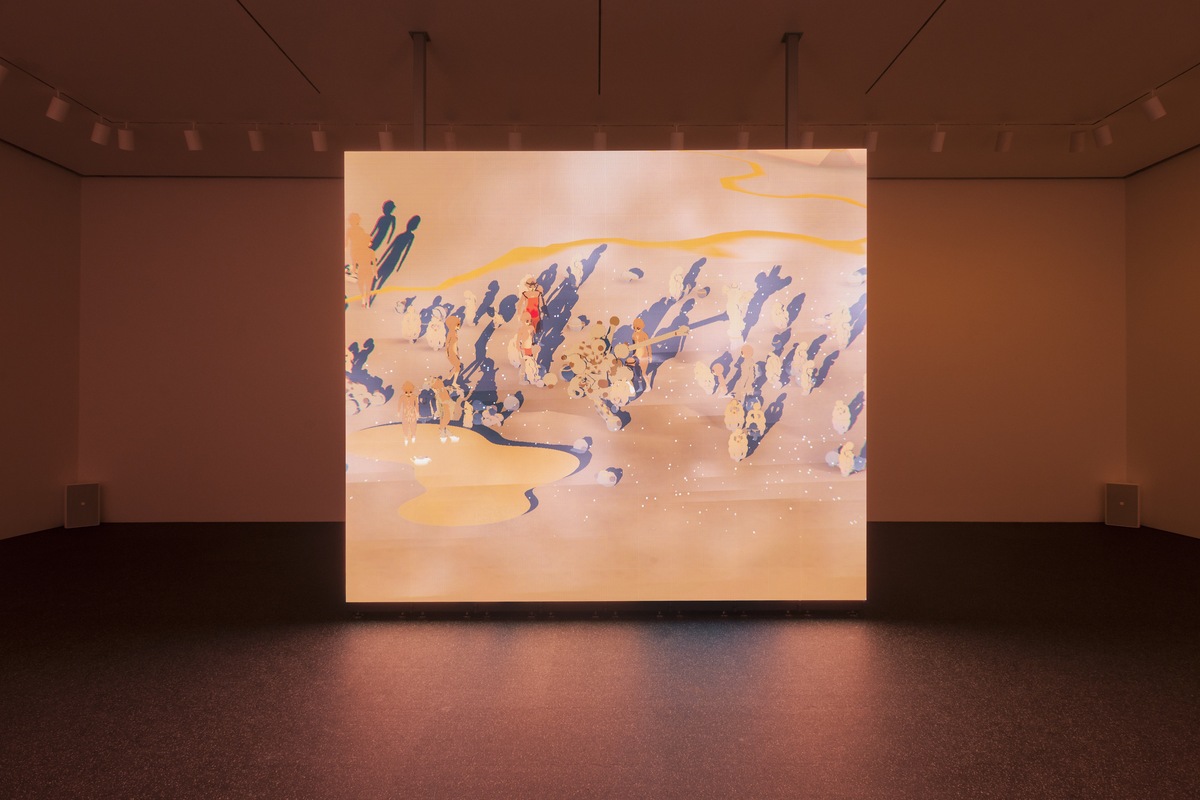
In Emissary Sunsets the Self, the humanoid figures, called “Oomen,” remain peripheral to the shape-shifting yellow puddle. A small bit of the puddle separates from the rest, and the camera tracks its movement as it floats away and attaches itself to one of the gray pieces of organic matter strewn about the landscape. Then ensues a rambunctious spectacle, accompanied by loud popping, whistling, and rustling sounds, as the symbiotic assemblage of yellow liquid and gray matter careens around the landscape like an otherworldly jalopy, accruing size and knocking things over.
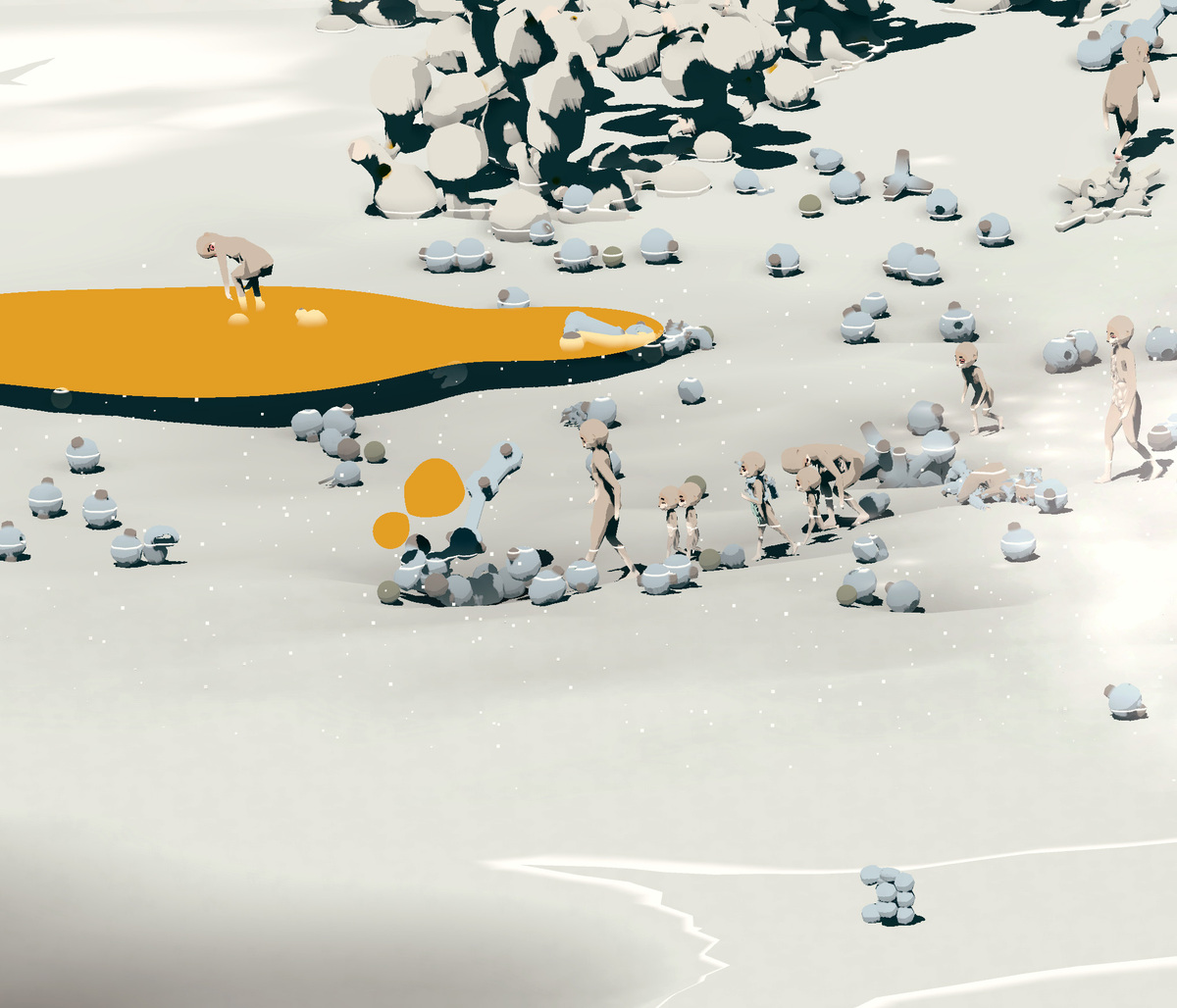
The Oomen flail and squawk, apparently upset. They are hardly characters that I can “identify” with, and neither is the leaf machine. In fact, there is nothing to identify with, and—more importantly—nowhere to identify from. The virtual camera floats strangely in its fixation on the growing gray creature, unsettling the viewer’s relation to the computer-generated images. The screen is not a neutral window onto a world, but an active interface, its isometric perspective reminiscent of a certain type of older videogame—and that is precisely what the CGI graphics, with their somewhat clunky animations, as well as the parallel projection method used in rendering the 3D environment, signal to me.
Except that this game is not driven by a player. It plays itself. We might say the human is taken out of the loop, but this isn’t wholly accurate. I am still here, looking. Physically, I am seated in a gallery space, looking across the room at a large, almost square-shaped screen (extending 12 feet up from the floor and with an unusual aspect ratio of 7:6) about 20 feet away from me. (My encounter with this work occurred in July 2022 at Stanford University’s Cantor Arts Center.) But I am also suspended in some indeterminate relation to the images on the screen. Rather than being engrossed in the images of prerecorded video art, I attend to the real-time generation of computational images. My usual modes of interacting with such images—videogame controller, keyboard, or VR headset—have all been denied to me. My body is called upon to act, or interact, but cannot. The centering of the yellow liquid suggests that this should be my point of interface, that my task should be to control its movement. But since I cannot, I feel more like it is controlling me, or at least controlling my visual access to the scene, giving the images and their motion a distinctly inhuman feel.
My body is called upon to act, or interact, but cannot.
The displacement of agency and general disorientation are not accidental. This is what Cheng calls a “live simulation”—an open-ended evolutionary system driven by AI agents interacting with environmental rules encoded in the physical properties of objects and their reactive potentials. Produced in the Unity game engine, the work is highly self-reflexive, framed in accompanying lore as an enigmatic story about a futuristic artificial intelligence, MotherAI, bored of its disembodied existence and driven to experiment with taking on material form. The yellow liquid is the AI’s emissary to the biotic realm, through which it is able to take possession of the surrounding fauna in, Cheng says, “an attempt to feel the sensations of incarnated life.” A real AI plays a simulated AI, and the videogame plays itself, thereby usurping the role of the human player now left feeling sidelined and strangely disembodied. My presence seems optional before a system that might go on forever, through endless cycles of virtual daylight and nighttime, through all the seasons, the AI never tiring of sending out probes, the camera always following its adventures in vicarious embodiment before resetting its gaze—over and over again but never twice the same—on the big yellow puddle at the center of it all. Where do I stand in relation to this system? Cheng’s artwork poses this question forcefully, its ambiguous non-interactivity calling upon us to rethink our phenomenological relations to a variety of contemporary images. Above all, it asks us to reassess the place of the perceiving body today. Sensation, the realm of the aesthetic in its broad sense, is made to feel weirdly out of time and out of place, without foundation, free-floating in a world transformed by the agency of artificial intelligence.
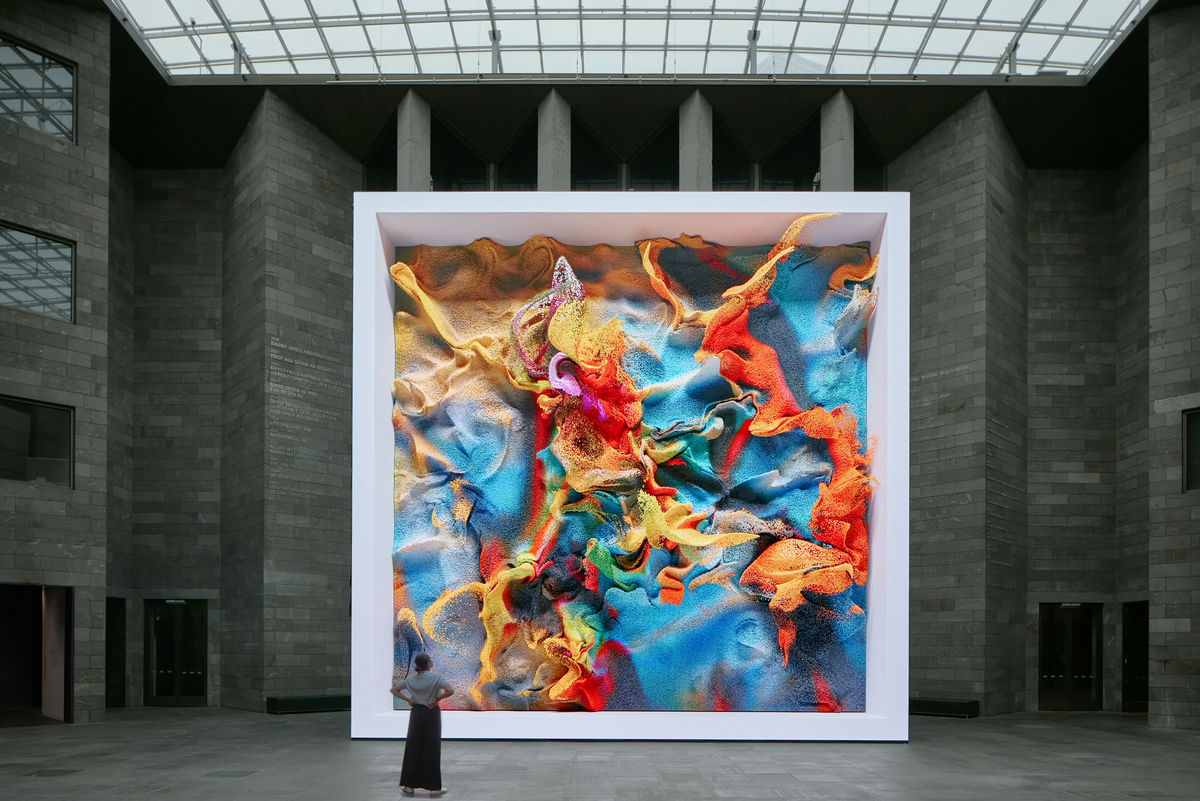
In his large-scale AI-driven installations, Refik Anadol gravitates toward spectacle and display—including the spectacle of cutting-edge display technologies. Against Cheng’s low-poly animations, his high-res imagery and larger-than-life screens take on a slightly futuristic aspect, in the way that bleeding-edge computer technologies position themselves ahead of the status quo. This situates the experience closer to the here and now, compared to the vast timescales envisioned by Cheng, on which the futuristic might very well collapse with the prehistoric. Still, the sheer scale of Anadol’s visual interventions marks them off from the mundane. Embedded architecturally into the built environment, they become environments of their own, transforming exteriors and interiors into porous gateways to a world of incessant change and transformation. The images themselves are largely non-representational, though they seem to mimic forms found in nature. Given both their overall size and the plethora of minutely calculated details they contain, Anadol’s works overwhelm the senses, confounding the viewer’s ability to perceive the whole picture and all its parts at once. Standing in front of such a display (as I have done in the lobby of the 350 Mission building in San Francisco), I experience visual wonder at the phenomenal flux I see on screen, but the more basic impact of the work is bodily and tactile: I am made to feel the power of generative AI, in inverse relation to my ability to filter a coherent image-object out of the visual flux.
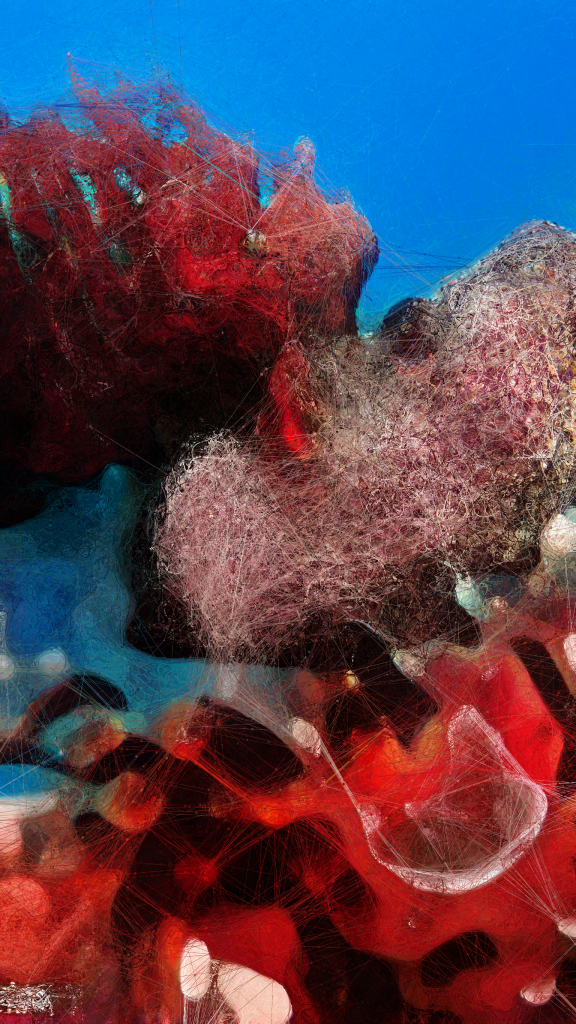
The underlying algorithmic processing is itself a kind of filtering. Diffusion models (such as those at work in the DALL-E 2, MidJourney, and Stable Diffusion image generators) filter images through layers of noise; first trained to recognize the way images in a dataset decompose through incremental additions of Gaussian noise, these models then use Markov chains to reverse the process, starting from a random noise image and denoising it by predicting a statistically likely arrangement of pixels according to a set of inputs (such as a textual prompt or an image to be upscaled, denoised, or inpainted) along with other parameters. Each level of filtering conditions and constrains the output that is possible—it refines and restricts the range of visible image-objects that can be produced by the model. But none of this filtering pertains to visuality. It falls outside the realm of perception. Nevertheless, this extraperceptual realm affects us deeply in our encounters with AI art.
Although this tactile power is best experienced in situ, the installation views featured on Anadol’s website foreground the stakes of these works. Many of them show a solitary figure before a giant display. The spectacle depends on an illusion of depth, shadows apparently cast from an overhead light source within the exhibition space (but actually calculated computationally and emanating from the flat screen itself). The impassivity of the viewer, dwarfed by the gargantuan scale of the display, serves as a kind of visual foil to heighten the tension. That nameless spectator thus provides the moorings for my own point of view, dynamizing my vision in contrast to her grounded stance. By way of such contrasts, these installation videos communicate a clear intention to overwhelm.
The true object of sublime wonder has shifted to the infrastructural conditions of sensation, and in particular to the invisible filtering operations of AI.
Anadol conjures a modified aesthetic of the sublime, reaching back to the early industrial-era origins of philosophical aesthetics and reworking one of its fundamental categories. In Kant’s Critique of Judgment (1790), there are two types of the sublime. The first he calls the “dynamical sublime,” and it threatens to overwhelm us physically. We feel small and fragile before the giant waves crashing on the rocky shore, or the massive storm gathering overhead. The second form, called the “mathematical sublime,” is less about physical fragility and more about our mental capacities and limitations, for example our inability to survey all the stars in the sky. The sheer number overwhelms our imagination, again making us feel small, but more in terms of our place, as thinking beings, within the incalculable expanse of the cosmos.

Since the time of the Romantics, both conceptions of the sublime have devolved into kitsch. But the underlying questions about embodied sensation and phenomena that exceed our powers of vision are germane in an age of AI and CGI. A quick Google image search for “mathematical sublime” returns not only nineteenth-century paintings, but also complex computer-generated topological models, as well as computer-aided and computer-enhanced images of the night sky. Often these images feature the silhouette of a lone human figure to emphasize scale, mimicking Caspar David Friedrich’s Wanderer above the Sea of Fog (c. 1818), which famously uses a human figure facing away from us, a so-called Rückenfigur, to evoke a sense of loneliness and wonder in the face of nonhuman nature. Note the similarity between Friedrich’s wanderer and the human figure in the installation view of Anadol’s Quantum Memories (2020). In both cases, the Rückenfigur highlights the sublime quality of the work. In Friedrich’s case, it is nature that is sublime, that refuses to be tamed and framed by human thought and perception, but in Anadol’s work it is a completely artificial reality that overflows its frame and threatens to engulf the observer.
Anadol’s work collapses Kant’s two types of the sublime: the observer is physically overwhelmed, as in the dynamical sublime; but the mathematical sublime is also in play, as we are aware that these images are produced by the unfathomable operations of superfast algorithms—mathematics itself—processing giant data sets that we could never hope to survey with our limited perceptual apparatuses. In the case of Anadol’s Quantum Memories, the images we see are produced by generative AI models, drawing on Google’s AI Quantum Supremacy experiments to synthesize new images on the basis of approximately 200 million nature and landscape images. It would seem that the true object of sublime wonder has shifted to the infrastructural conditions of sensation, and in particular to the invisible filtering operations of AI.
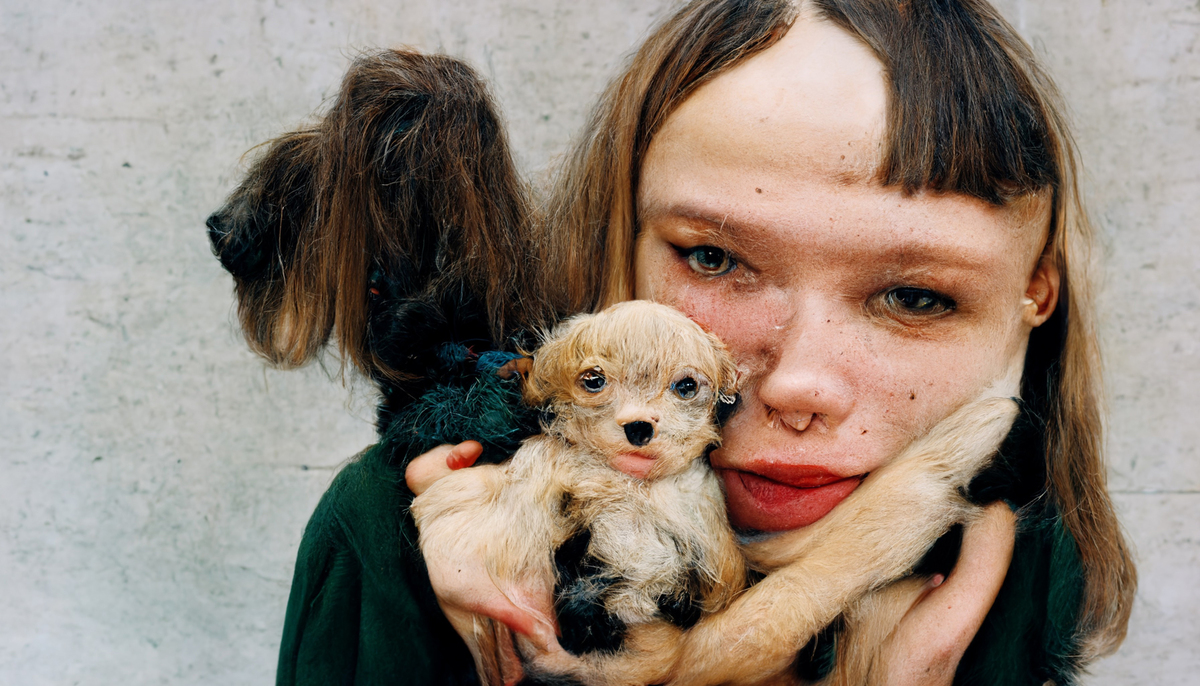
Jon Rafman’s recent work uses AI to engage the body through a more vernacular, cringe aesthetics. The exhibition “Counterfeit Poast,” presented at Sprüth Magers in Berlin in 2022, revolved around a 28-minute video installation of the same name. The video is comprised of eight chapters, each introduced by a title card resembling a Reddit-style social media post: “I gaslit my girlfriend,” “Sigma Male Routine,” and “GOT REKT.” These are tales of born-digital, networked experience, filtered through platform protocols, anonymous exchange, and the ensuing toxicity. Their narrators exhibit a limited range of facial expression (nodding, jaw and eye movement) that, because the rest of their body and head remains static, imposes unnatural distortions, for example stretching their heads and necks or smearing their facial features. As the tales unfold, these animated sequences are interspersed with bizarre static images—often grotesque, violent, and overstuffed with trash—that roughly correspond to the scenarios described in voiceover.
Against the aesthetics of weird detachment, Rafman’s images invoke a gross-out aesthetic that underscores a material connection to the underside of online life.
Shown alongside paintings generated with text-to-image algorithms, the video’s images are recognizably produced with the same diffusion techniques, while iPhone face filters are used to create the animations. Glitchy and nonsensical textual elements, impossible anatomies, misplaced hair, superfluous fingers and eyes, and haunting deformations—these are the familiar signatures of the underlying algorithms. Against the aesthetics of weird detachment and of the overwhelming sublime, Rafman’s images invoke a gross-out aesthetic that underscores a material (and perversely spiritual) connection to the underside of online life today.

Rafman’s character studies are based on the repeatedly copy-and-pasted texts found on online forums known as “copypasta,” and the so-called Mandela Effect, according to which false memories are shared collectively and rumors of them circulate, meme-like, online. For instance, the episode titled “The Traveling Salesman” revolves around a woman’s false memory of a nonexistent movie from the 1990s, set in a post-apocalyptic America and starring Kevin Costner in the titular role. Listening to the woman recount her memory, I was genuinely confused and had to search the internet to make sure the film indeed never existed; apparently, the narrator and I had both confused it with The Postman (1997). Filtered through these common experiences of online life, as well as the visual record of the internet from which the images are synthesized, Rafman’s video invites confusion and merges synthetic memories of narrator and spectator alike, mimicking and perpetuating the process of online circulation.
Through this engagement with the internet and its underbelly, as mediated through synthetic digital technologies, Rafman’s work with AI shifts from more traditional grotesquery to contemporary cringe. Here, cringe involves a recoiling from the ugly, unethical, or offensive. It involves a reassessment of individual agency in the face of mediated misinformation, the overwhelming scale of which might otherwise feel sublime but here just feels kind of gross. A bodily discomfort creeps in to underline the more reflective discomfort we might feel when viewing the work’s algorithmic treatments of race, gender, normative body size and shape, and other sensitive matters of embodied and social existence. The overweight boy at the heart of “I am a Walrus” tells us that he is in fact a walrus, and asks for donations to support his full medical transition; the disturbing images of human and animal bodies that illustrate his tale uncomfortably recycle normative standards while ambiguously broaching topics of fat-phobia and transphobia.
Problematic narrative and visual depictions provoke the alienation of cringe aesthetics, opening a space for embodied recoil where human and machine hallucinations are confronted with the embodied effects (and affects) of normative typification. Counterfeit Poast is a deeply troubling work, not merely because it draws on and reproduces racist, sexist, and other troubling tendencies of online life, but because it forces the viewer to intuit the latter not simply as “algorithmic bias” but as material powers with direct, tactile force. The aesthetics of cringe is at once a defense mechanism designed to keep ugly feelings at arm’s length and an embodied recognition of the impossibility, in an age of predictive algorithms, of such protective and extricating measures.
Challenging our ability to perceive, these works throw us back on the resources of the body.
These works by Rafman, Cheng, and Anadol implicate the viewer in a corporeal process that significantly mirrors underlying computational processes. Non- or preperceptual filtering is operative on both sides, both that of the machine and that of the human body. Humanly embodied and machinic filtering processes interface directly, if non-consciously and sub-symbolically, and interact with one another—perhaps antagonistically, in a sense recalling the antagonism at the heart of generative adversarial networks, or GANs—in the co-production of a visible spectacle. Challenging our ability to perceive, these works throw us back on the resources of the body. Perhaps, before we can begin to make sense of things, we’ll have to assess how—by what mechanisms and to what ends—AI art makes us feel.
Shane Denson is an associate professor in the department of art and art history at Stanford University and author, most recently, of Post-Cinematic Bodies (2023).
